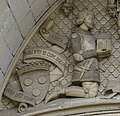Elected Counts of Auvergne (480–963)

Visigoth period
- Victorius (480–489)
- Apollinaris (489-515)
Frankish Merovingian period
- Hortensius (516-532)
- Sigivald (532)
- Becco (533)
- Hortensius (533-?)
- Evodius ?
- Georgius ?
- Britianus ?
- Firminus (c. 555 or 558, deposed)
- Sallustus (duke c. 555 or 558–560)
- Firminus (restored, 560–571)
- Venerandus (before 585)
- Nicetius I (duke and count c. 585)
- Nicetius II (c. 585)
- Eulalius (duke 585–590)
- Bobon of Neustria (639–656)
- Hector of Neustria (c. 655–675)
- Bodilon of Austrasia (c. 675)
- Calminius of Neustria (c. 670s)
- Genesius (c. 680s)
- Haribert of Neustria (c. 690s)
- part of Neustria until 751
Frankish Carolingian period
- Ithier (c. 758)
- Blandin (760–763)
- Chilping (763–765)
- Bertmond (765–778)
- Icterius (778–?)
- Warin I (818-c.820)
- Warin II (c.820–839), son of previous
- Gerard (839–841), supposed brother of previous
- William I (841–846)
- Bernard I (846–868)
- Bernard II Plantapilosa (864–886), married Ermengard, daughter of, Bernard I
- William II the Pious (886–918), son of Bernard II, also duke of Aquitaine.
- William III the Younger (restored, 918–926), son of Adelinda, daughter of Bernard Plantapilosa, also duke of Aquitaine.
- Acfred of Aquitaine (926–927), brother of previous.
After the death of Acfred, who left the comital fisc completely diminished, there appeared no successor who could control the entire Auvergne, with Velay. Several relatives of surrounding regions made claims. Below are the dates of their effective control.
- Ebalus Manzer (927–934), great-grandson of Gerard
- Raymond Pons, Count of Toulouse (934–942)
- Raymond, Count of Toulouse (942–961)
- William (IV) (961–963), son of Ebalus Manzer, also Duke of Aquitaine.
















